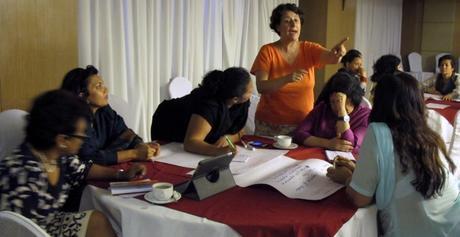
Participants at a Women’s Business Network meeting in Nepal in 2014.
By Hanna Pioske
The word “intersectionality” is thrown around a lot these days. Political candidates use intersectional rhetoric in their campaigns, and organization after organization publish reports on the benefits of creating intersectional programming. Everyone seems to be using the term as a buzzword to add legitimacy to their beliefs. But what does intersectionality truly mean, and what lessons can the international development community take away from it?
Intersectional theory originated in academia as a way to explain the dual oppressions African-American women faced from the combined effects of racism and sexism. In 1989, African-American legal scholar Kimberle Crenshaw coined the term intersectionality in her seminal work “Demarginalizing the Intersection of Race and Sex: A Black Feminist Critique of Antidiscrimination Doctrine, Feminist Theory and Antiracist Politics.”
In the article, Crenshaw compares multiple axes of oppression to a car accident in an intersection. Much as a car in the middle of an intersection can be hit by vehicles coming from any or all directions, an African-American woman can be discriminated against through racism, sexism, or both. Since this first use, the term has expanded beyond the particular struggle of African-American women to include multiple intersections of gender, such as class, disability, religion, and sexual orientation.
The main lesson from the intersectionality movement is that prejudice against women cannot be viewed in a vacuum. Race, class, gender, sexual orientation, and other social signifiers all combine to determine how a person experiences oppression. It is important to realize this when creating programming to address gendered problems. Not all women in a community face the same kind of discrimination or have the same needs. Economically disadvantaged women, uneducated women, and women from different ethnic groups experience oppression and privilege in unique ways. In some cases, doubly marginalized women are afraid to speak out on specifically gendered issues for fear of betraying their community.
Often, the struggle for women’s equality in developing countries emphasizes the rights of individual women, whereas movements for indigenous groups prioritize the group’s collective identity and right to cultural integrity. Women who are members of both these groups may experience gender equality efforts in a unique way.
Assuming that women’s marginalization is a result of gender alone ignores complex cultural and social networks that determine one’s place in society, and gendered programming should be created in a way that keeps this in mind.
For example, female entrepreneurs face significant challenges to starting and growing their businesses. CIPE’s partners have found that women-focused business associations can help to address problems that particularly affect women. Going one step further and incorporating intersectional approaches into these associations can help ensure that all women benefit from entrepreneurship programs.
As the term intersectionality grows ever more popular, it risks losing some of its original meaning and intent. Social movements or programs that include a diverse range of people but do not center their experiences within the movement fail to be truly intersectional.
An Oxfam report on repoliticizing intersectionality tells the story of a group of young women in Latin America who, frustrated with the feminist movement, told a conference “We’re not here as folklore! We’re not here to make the movement look more diverse. We have issues that we want to discuss, and they’re different than the issues you want to discuss. We have our own political agenda, and it needs to become part of your agenda.”
If development organizations are sincere in their desire to create intersectional programming, they must heed the advice of these young women and incorporate marginalized groups’ agendas for change into their own.
Crenshaw concludes her essay by writing, “If efforts began with addressing the needs and problems of those who are most disadvantaged and with restructuring and remaking the world more necessary, then others who are singularly disadvantaged would also benefit.” By listening to the most marginalized groups of a community, development organizations can help combat oppression at all levels of society and rebuild communities from the ground up.
Hanna Pioske is an intern with CIPE’s Women’s Entrepreneurship Staff Forum (WESF).

